Reims have surprisingly become one of the best defences in Europe’s top five leagues this season and the best in Ligue 1 with only 21 goals conceded from 28 games. That’s three goals conceded less than table-toppers Paris Saint-Germain and third-placed Rennes who have also been quite solid in the current campaign.
Credits primarily should go to manager David Guion whose tactical choices and philosophy have helped bring the best out of a low-budget Reims squad. After bringing the team up to Ligue 1 in 2017/18, Guion brought Reims to finish on the upper-side of mid-table, finishing eighth in their first season after promotion, in the 2018/19 season. And now, they may have a chance to snatch themselves a European spot as they’re currently sitting fifth on the table with 41 points, eight less than fourth-placed Lille with ten games to go. It certainly will be interesting to see whether or not they’ll be able to finish high on the table, especially with such a cheap yet talented squad.
In this tactical analysis, we’ll dissect and analyse the tactics used by Guion this season at Reims.
Favoured formations

At Reims, Guion mainly uses 4-2-3-1 with some variations of it (4-4-2, 4-4-1-1 (one main striker, one supporting/secondary striker) as his preferred formation although there are times where he’ll use a 4-1-4-1/4-3-3 in a game. His tactics and player choices are quite consistent and he tends to keep most of the players that started in the previous match in the starting lineup for the following fixture, preferring to only do small squad rotations rather than big rotations in every fixture.
Predrag Rajković is a mainstay in the goalkeeper post. The Serbian goalkeeper is extremely vital to Reims mainly because of his suitability to the system and, of course, his impressive ability. The 24-year-old goalkeeper is neat on the ball and has good passing ability in open play. To add to that, his anticipation, judgment, and quickness when coming out are outstanding, making it very hard for the opposing teams to play passes into the back of the defence.
In front of him, Axel Disasi and Yunis Abdelhamid have been the main centre-back partnership at Reims. Both centre-backs are very strong and athletic. Both are quite aggressive and physical and are dominant in the air. Though both centre-backs can’t be described as ‘explosive’, both actually have pretty good pace over long-range, so catching up with opposing attackers or tracking back can be done in a fairly quick fashion and they’re both not that prone to losing foot race, especially over long-range. Both, however, are rather lacking in agility and can be beaten by attackers who are quick on the turn.
Thomas Foket and Hassane Kamara are the main pair of full-backs with the former playing on the right side while the latter plays on the left. Ghislain Konan also has his fair share of game time, playing on the left while Foket or Kamara plays as his counterpart. Guion’s system uses offensive full-backs who are also highly disciplined in defence and these players perfectly match his system.
The midfield and forward choices are rather flexible and they tend to experience more rotations than the players playing in the defence.
Attacking style
Reims usually look to play from the back and they’re quite patient in the build-up. They’ll look to move the ball around at the back and create spaces and openings by attracting pressure. However, once they get past the first line of pressure and get the ball into the middle third, they become much more straightforward and play with higher tempo, either by exchanging quick one-two touch passes or dribbling directly into the heart of the opposing defence.
Guion’s side mainly look to play through the flanks rather than through the middle and will look to create chances from wide areas either through crosses from wide or by cutting inside and driving into central areas deep inside the opposing half. The striker usually tends to move wide or sit in the half-space rather than staying centrally. He’ll usually look to get involved in the build-up by dropping to receive and linking play. By dropping, he’ll usually also drag out an opposing defender which could cause an imbalance in structure.
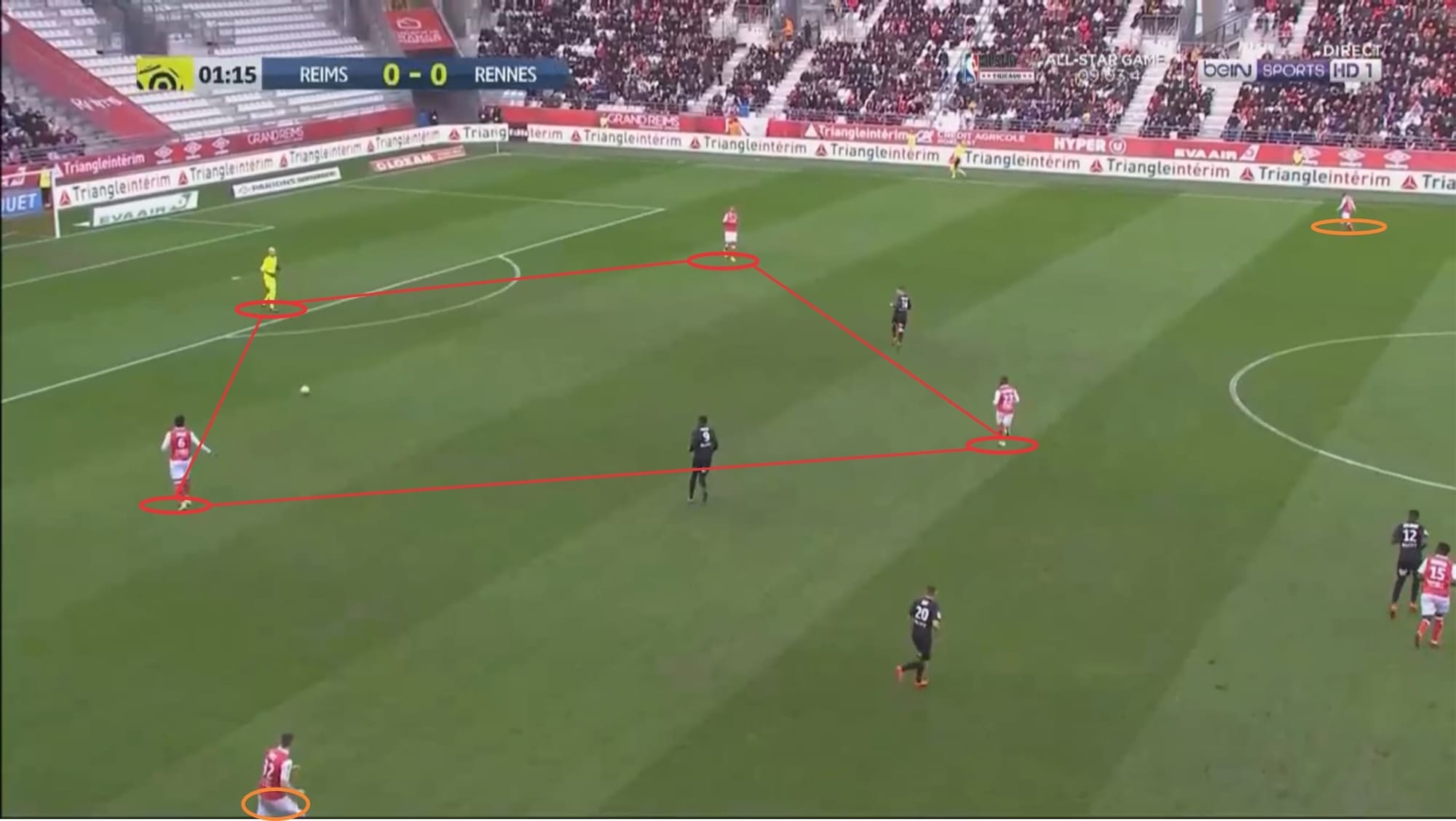
When playing out from the back, Reims usually take up this shape. Although they usually play with defensive/central midfielders, only one will act as a pivot and will occupy the ‘6’ space. When Rajković plays, he’s usually heavily involved in the build-up, coming out of his line and exchanging passes with his teammates. By doing so, Reims usually have a superior number in the build-up which helps them circulate the ball in an easier and more comfortable fashion despite having to endure high pressure from his opposition. With one pivot staying centrally and the goalkeeper getting involved, a diamond shape is created.
The two full-backs (orange circles), meanwhile, will sit rather high and wide to stretch the defence and making themselves available as options to play the ball wide. They’ll usually drop deep to support the build-up when the backline is receiving too much pressure and need to support to get out. A clearer picture can be seen in the tactical board below.
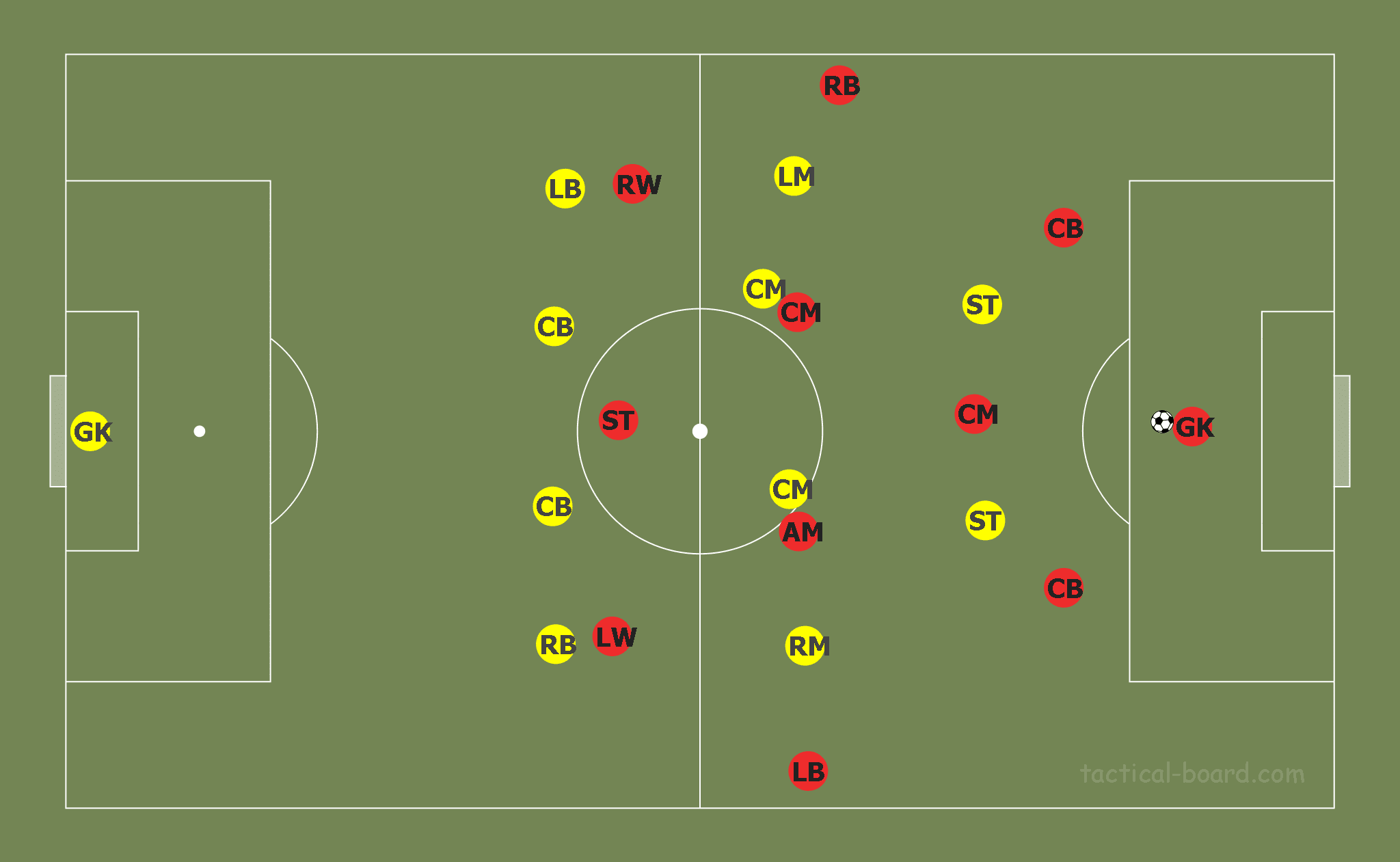
You can see in the image above that the attacking midfielder will drop and occupy the space that was vacated by the midfielder that plays as a ‘6’. With this shape, they actually look as though they’re playing with a 4-3-3 instead of 4-2-3-1.
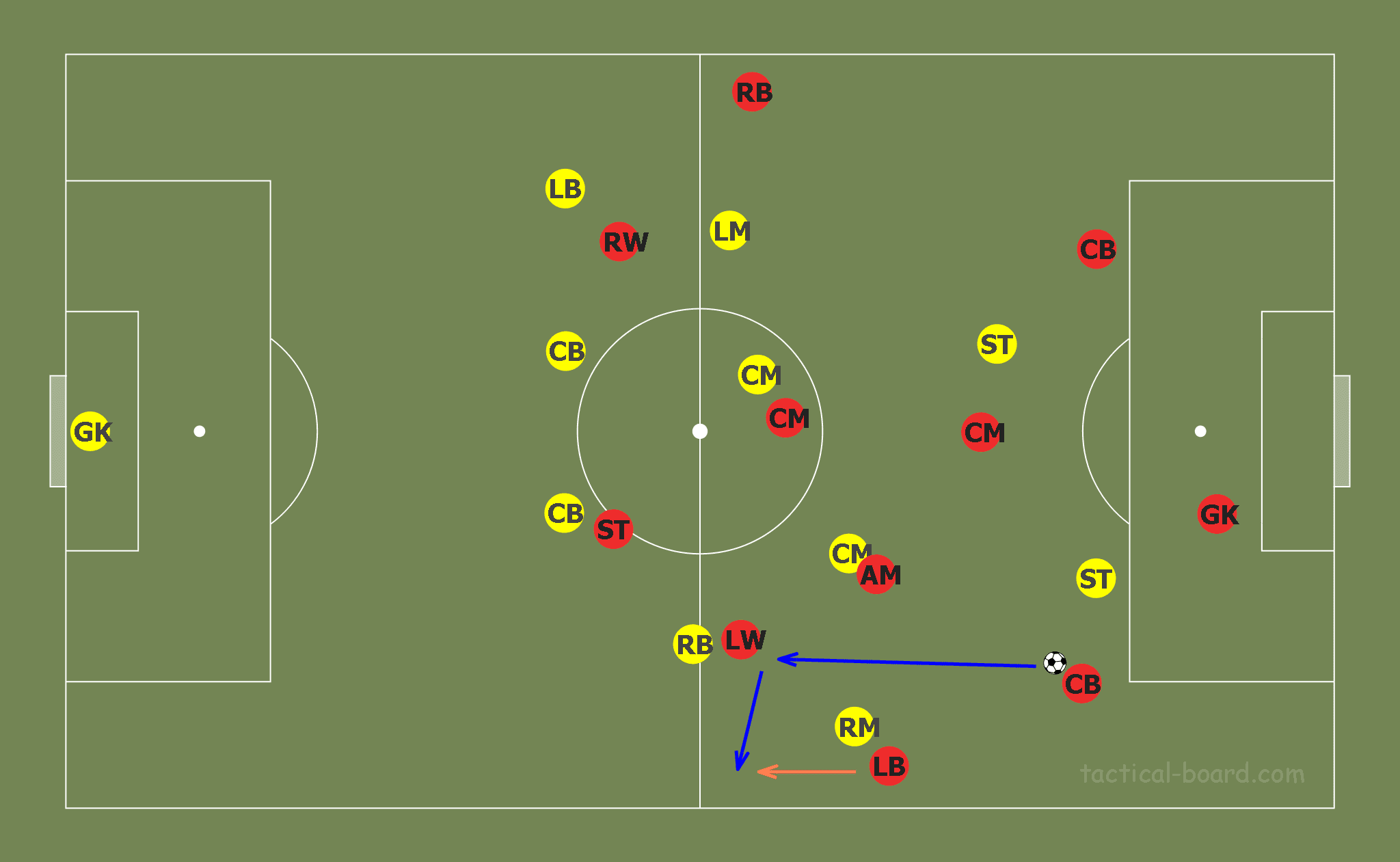
In the scenario above for example, the goalkeeper passed the ball towards the left-sided centre-back. The opposing striker starts to close him down and blocks his passing lane towards the goalkeeper, thus steering him to the flank. In this case, the left-back will then drop to support. As you can see above, the attacking midfielder and left-winger also moves closer, again, creating a diamond shape to allow easier and effective circulation. In this case, the centre-back usually plays the ball towards the dropping winger and the winger will then play the ball onto the path of the full-back who will quickly turn and beat his marker to the ball.
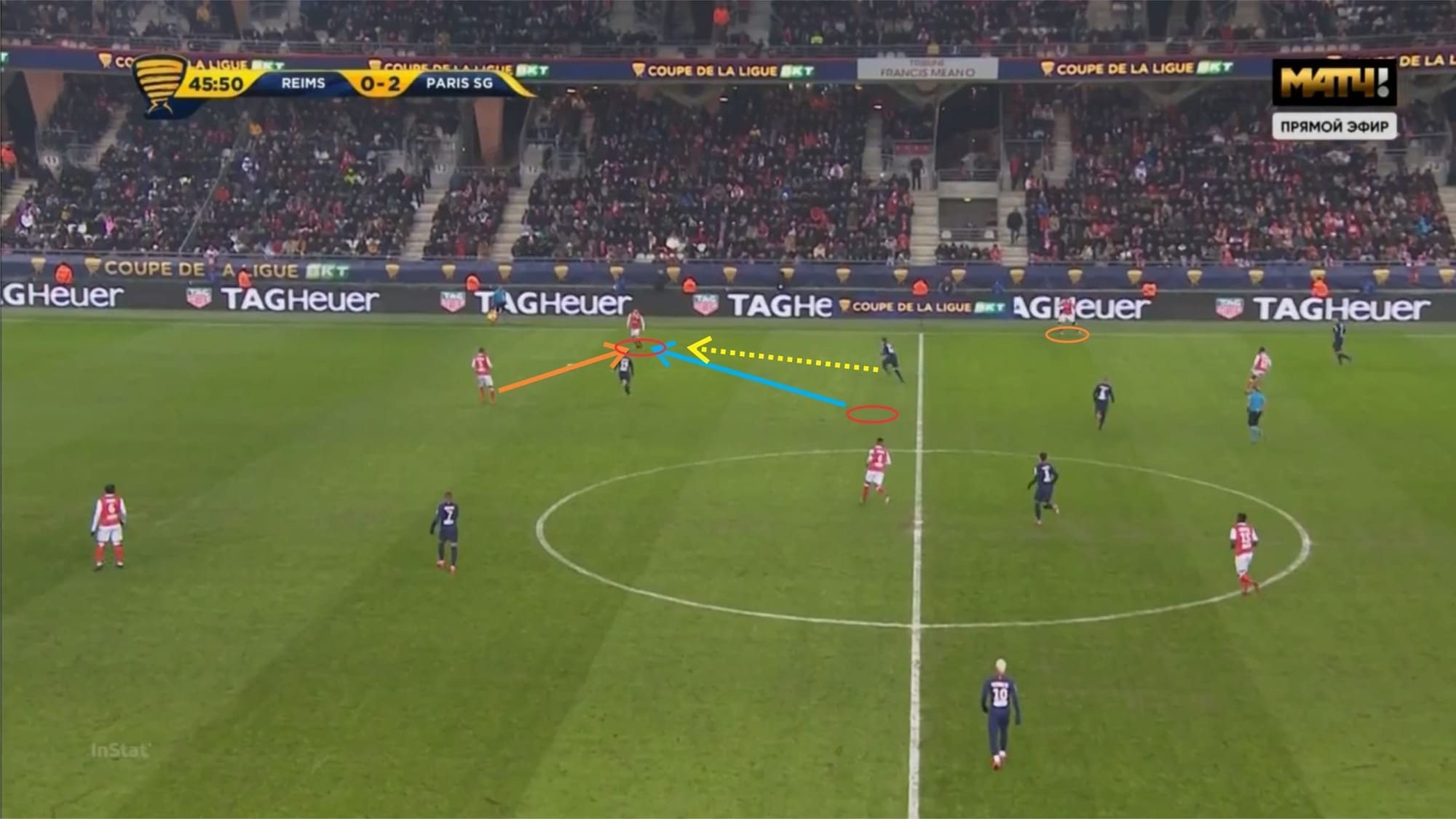
At certain times, they’ll also create a three-man backline in the build-up by having one defensive/central midfielder dropping and sitting in between or beside the two centre-backs. This can create a similar situation as can be seen in the two images above. In the particular situation above, Xavier Chavalerin dropped and sit beside the two centre-backs, vacating his position and leaving Alaixys Romao as the lone pivot. When the ball was moved wide towards Chavalerin, the right-winger of PSG was attracted and would press the ball carrier. This left the left-back of Reims with more freedom and created a 2v1 stagger between the two wide players of Reims and the full-back of PSG. With the opposing winger having to cover a decent distance to close down the ball carrier, Chavalerin has enough time to move the ball towards the left-back and Reims can both get out of pressure and quickly attack PSG from the flank.
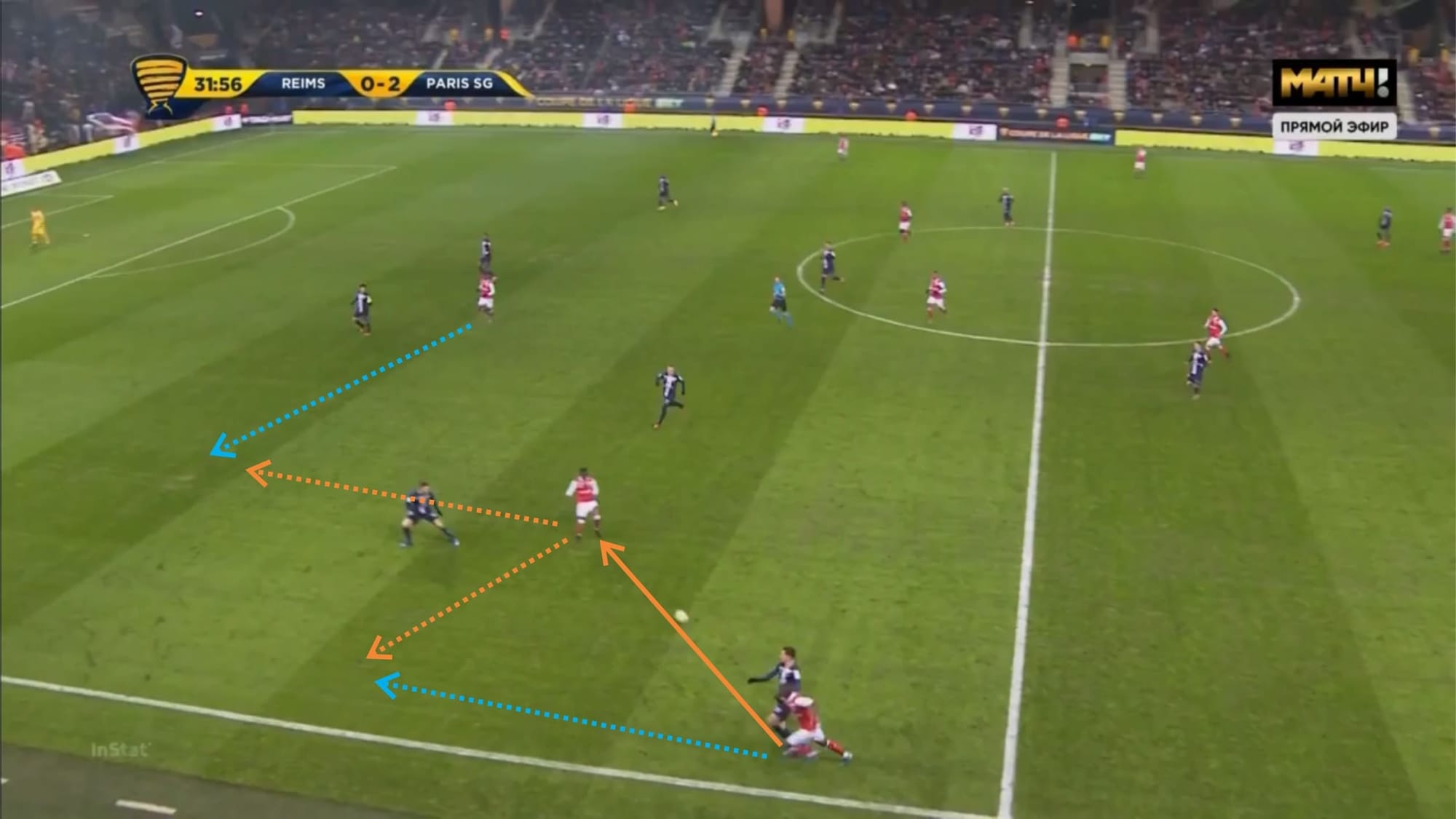
As mentioned earlier in this tactical analysis, Reims tend to play through the flanks and create chances from wide areas. Though they’re quite patient at the back, once they exit the first line of pressure, they play with a higher tempo and more directness. In the image above, for example, Konan received the ball from the back and brought the ball forward before passing the ball towards the left-winger who dropped and dragged the right-back of PSG out. As you can see, the striker can be seen moving wide out of his designated position. Upon receiving the ball, the winger then had the chance either to play the ball back to the advancing full-back or play the ball onto the path of the striker who roamed wide.
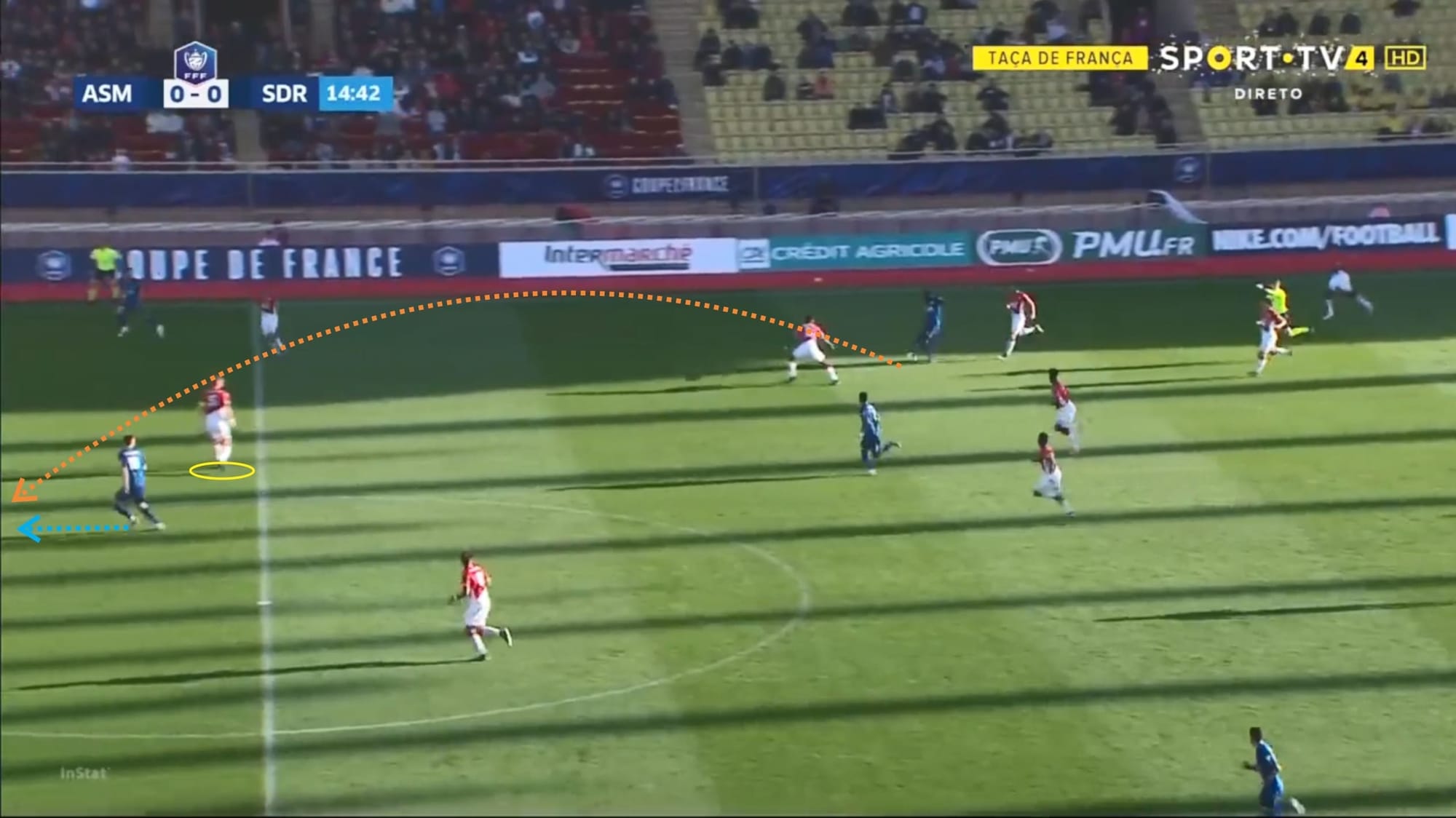
When in attacking transition, they’ll deliver the ball forward with a very high urgency. Players will quickly dash forward rather than coming down to receive and combine. Rather than quickly combining and moving forward with short passes, they’ll either drive forward quickly with the ball (if allowed space) or play long balls into space as in the image above. In the example above, however, the Reims forward was caught offside as the Monaco defender managed to execute a perfect and well-timed trap.
Tactical tendencies in defence
Reims mainly defend with a medium-high block, but against stronger opponents, they may sit deeper. Their defensive approach against stronger opponents may also affect their attack as they become more direct and rely more on long balls and counter-attacks.
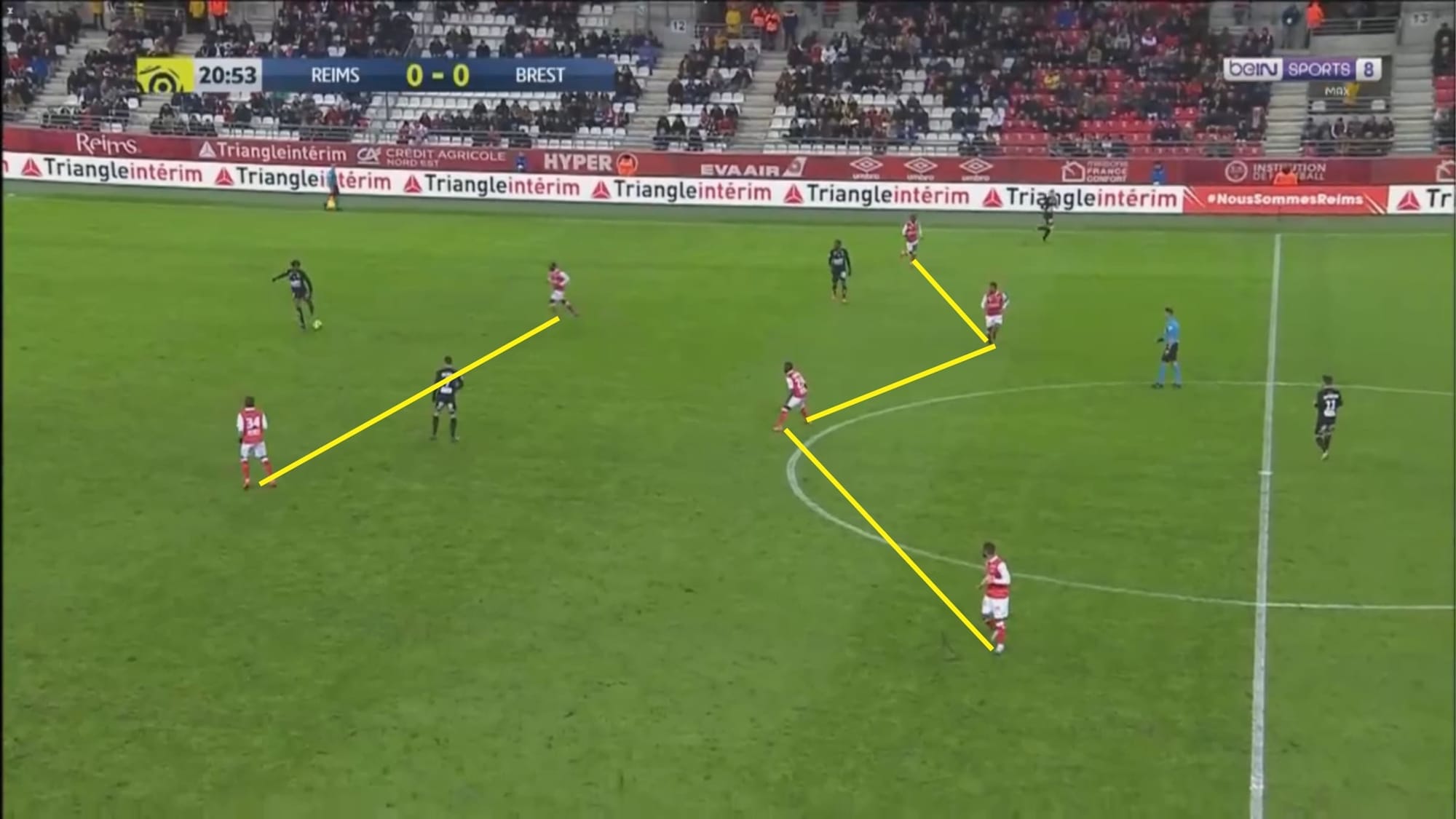
In a 4-2-3-1/4-4-1-1/4-4-2 formation, they’ll defend with a 4-4-2 medium-high block. The first line of pressure is quite high and moderately aggressive.
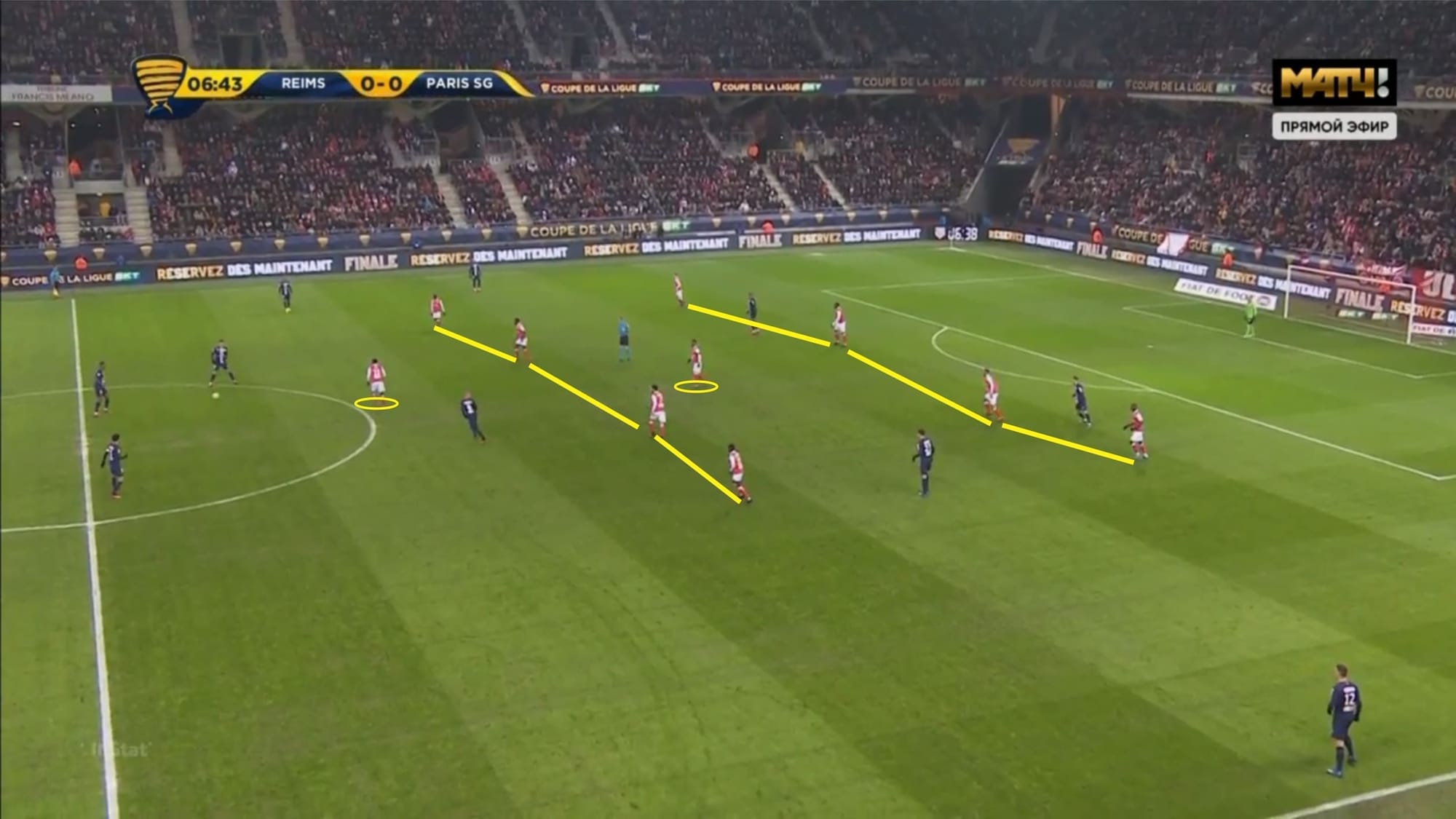
When in a 4-1-4-1/4-3-3/4-5-1 formation, they defend with a 4-1-4-1 block. In this particular situation, they played against PSG and aimed to absorb pressure and then quickly break forward via counter-attacks. As you can see, the block is quite narrow. They don’t allow access to the middle and will look to force the opposing team to play around the block. Though they’re quite narrow and tend to give an abundance of space on the flanks, when the ball is moved wide by the opposing player, they’ll quickly move their block and overload that side of the pitch.
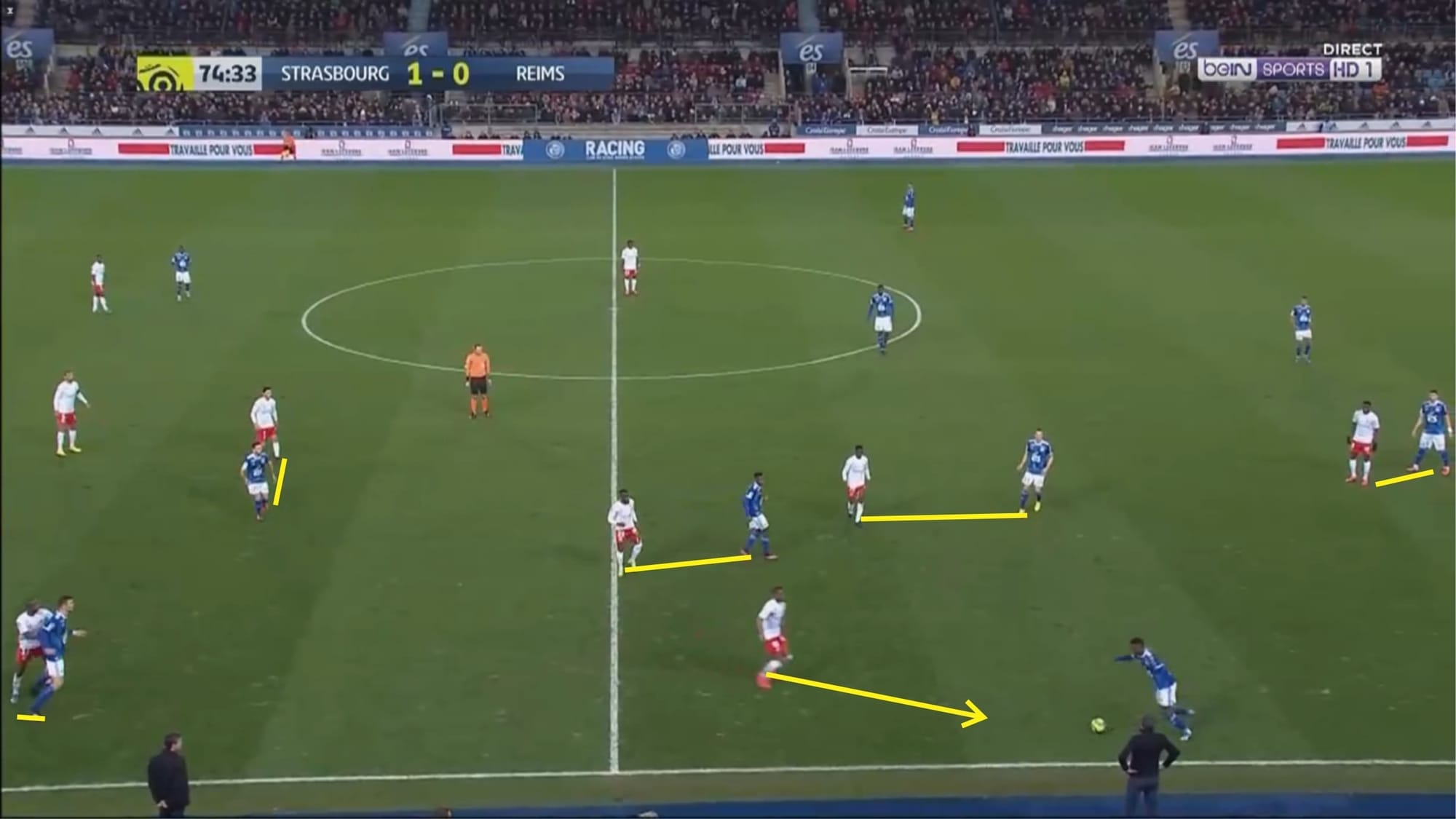
As you can see above, Reims immediately moved the block and overloaded the flank when the ball was moved wide by a Strasbourg player. Though they mainly defend with a mix of man and passing lane-oriented coverage, when the ball is moved wide, the ball-near players momentarily become strictly man-oriented, while the ball-far players cover space.
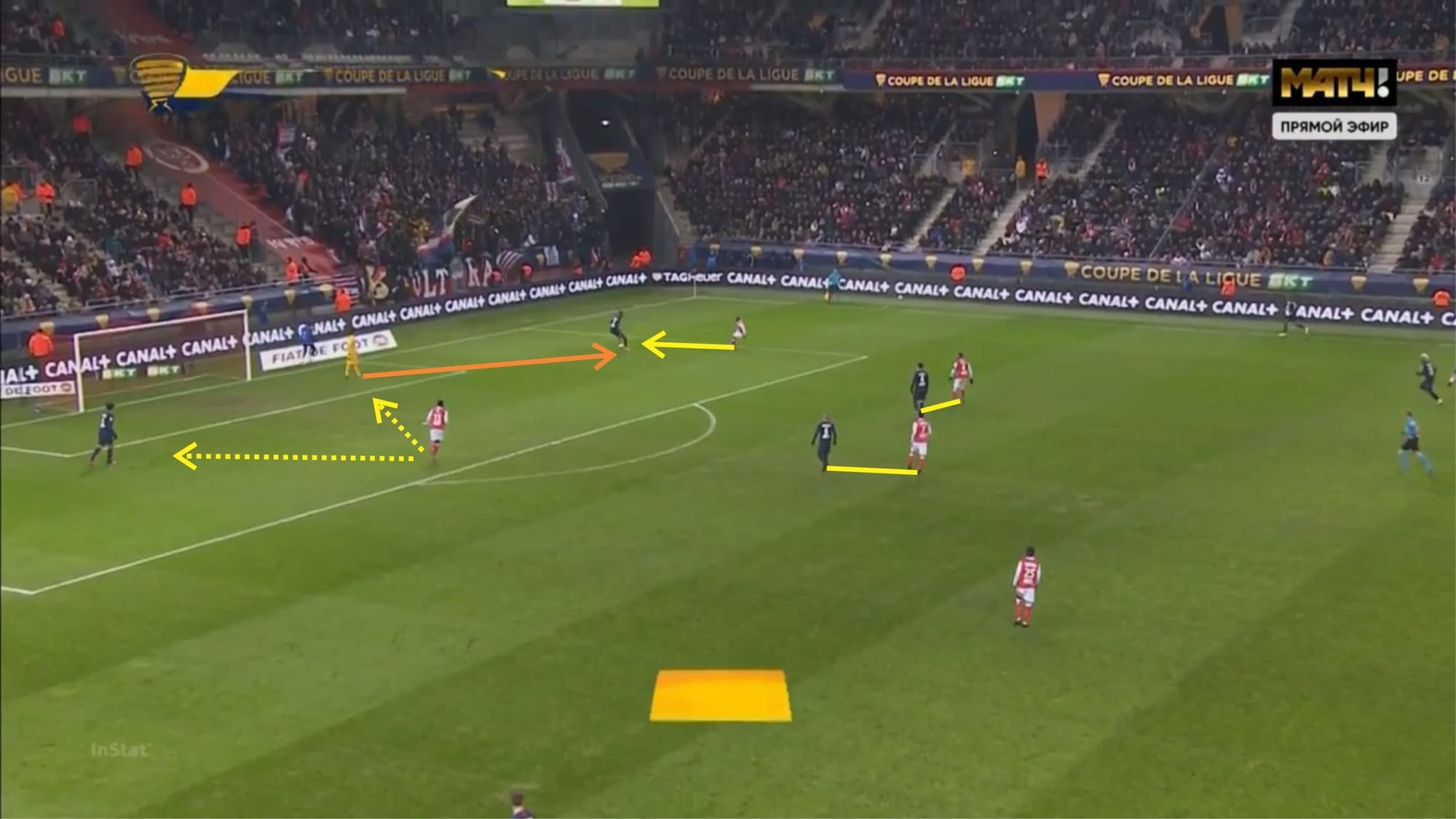
Although they tend to defend with a medium-high or medium-low block, Guion’s side always press high when the opposing team play from the back. They are man-oriented in pressing and as mentioned previously, their coverage is both man and passing lane-oriented in marking. Above you can see the two Reims midfielders tightly marking PSG’s two pivots man for man, while one of the strikers kept a close distance in between the opposing goalkeeper and the right-sided centre-back in order to anticipate if a lateral pass was played. The other forward, meanwhile, pressed the ball carrier aggressively while coming from his side in order to block the passing lane towards the left-back. This would force the ball carrier to make a decision and execute his action quickly. Mainly, the ball carrier would play the ball long either diagonally or straight upfront instantaneously, allowing Reims to have a chance to collect the second ball and break forward.
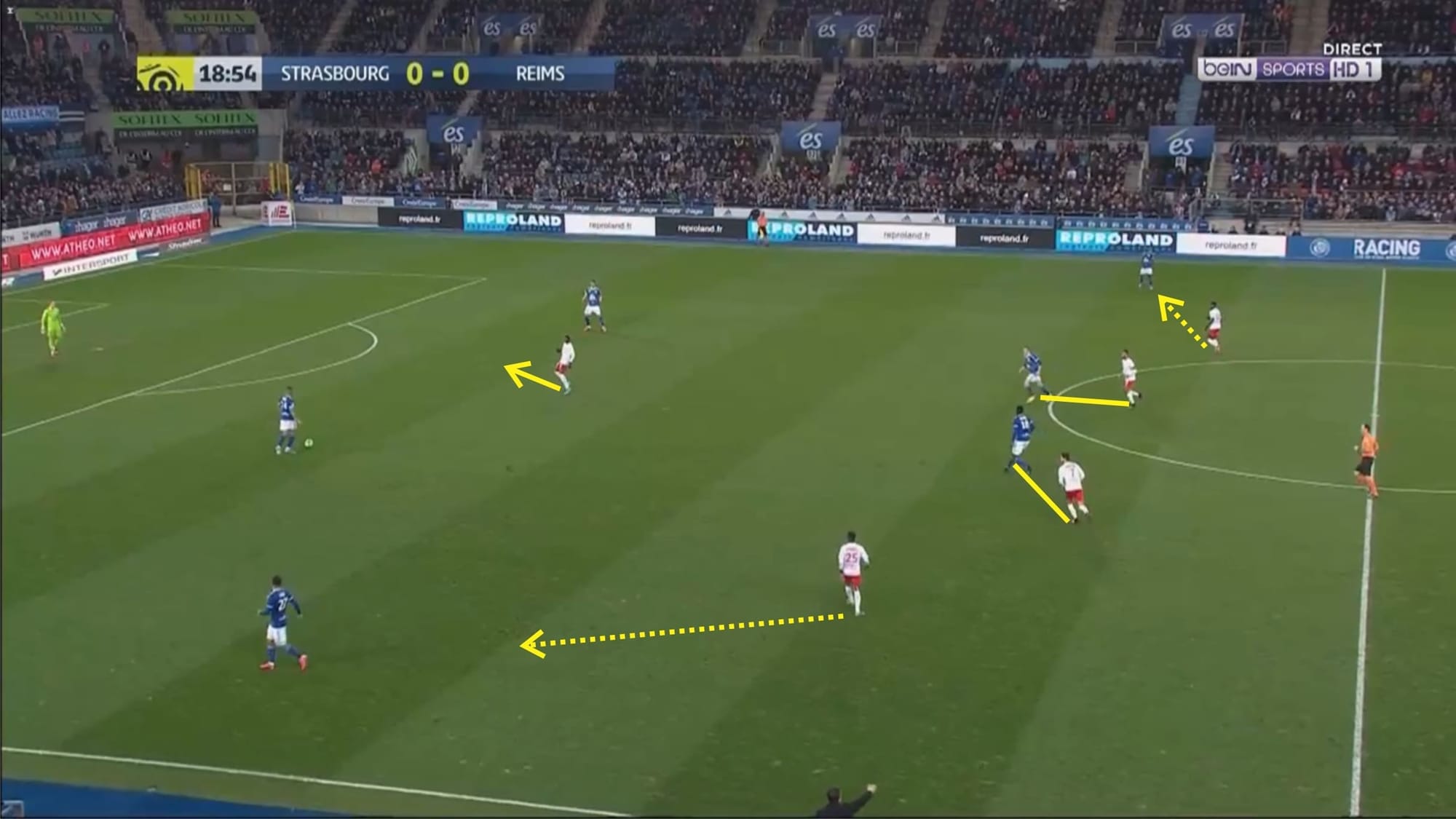
Pretty much the same approach can be seen in their 4-1-4-1 block. Reims’ defending is smart and effective and as mentioned before, they rely on cutting off options via passing lane and man-marking. Players tend to look at the ball carrier’s body shape in order to read the game. In the situation above, the ball carrier’s body shape indicated that he was looking to play the ball laterally. Instead of closing the ball carrier down squarely, he blocked his passing lane while slowly closing him down. As you can see, the central options were also blocked with the two ‘8’s tightly marking the Strasbourg central players. Meanwhile, the two wingers gave space for the full-backs to receive but would quickly close them down when the ball was played towards them.
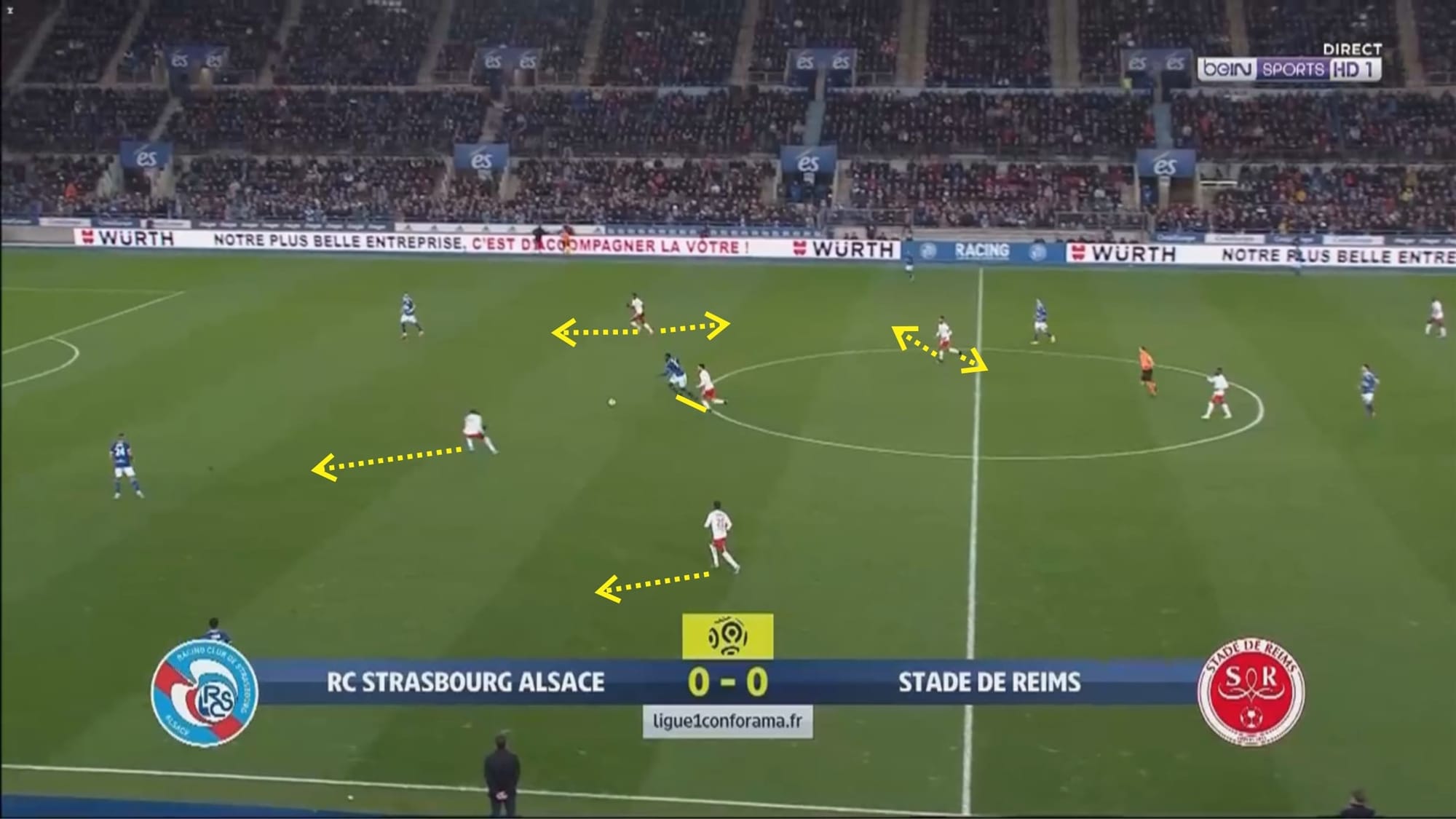
If the ball is played towards a central player that is marked tightly, the ball receiver is usually met with aggressive and very tight pressure. This is so that the ball receiver does not receive the ball comfortably and unable to turn and progress the ball forward. In the example above, Chavalerin quickly closed down Ibrahima Sissoko when the ball was played onto his feet. This resulted in him unable to turn and his touch was rather poor.
Upon seeing poor touches, mistakes, or poor passes from the opposing player, Reims will usually be triggered to immediately push forward and pile more pressure in order to win the ball high up the pitch. As you can see above, Chavalerin continued pressing man for man while the two wingers and the striker were looking to block the ball carrier’s passing lane to the backline, not allowing him to relieve the pressure and recover to restart the attack from the back.

When the ball is played into the block in central areas, they will quickly compress space and swarm the ball carrier whilst also looking to block passing lane towards nearby options. Again, the man-to-man pressing is aggressive and if a player receives the ball with his back to goal, he will have a very hard time adjusting his body shape and turning.
Conclusion
Reims have been very solid under Guion and their excellent performances have brought them great success. If the season is resumed, they’ll have a chance of qualifying for Europe. It will still be quite challenging for them as their competitors are quite powerful as well. But if they can maintain their consistency, we may see them playing in Europe next season which is a highly impressive achievement for a rather underrated but brilliant team.




Comments